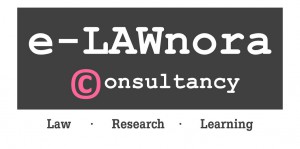There have been four major legal copyright cases that have an important impact on the media monitoring industry. In this interview we ask Eleonora Rosati, an independent copyright law & policy consultant, lecturer in intellectual property law at the University of Southampton and Editor of the Journal of Intellectual Property Law & Practice (Oxford University Press), to take us deeper into the rulings.
(This interview of Eleonora with Sophia Karakeva was first published in the 1st issue of 2016 of the FIBEP FT&C Newsletter).
Q: Let us start with the NLA vs Meltwater & PRCA case where CJEU found that browsing the Internet without asking permission is not copyright infringement. How far can copyright law be applied to the technical processes that are involved in viewing copyright material on the internet given that search engines are constantly improving with better techniques to harness news?
ER: In its Meltwater decision the Court of Justice of the European Union (CJEU) confirmed the view of the UK Supreme Court (that had referred the case) that indeed this kind of activity would fall within the scope of the copyright exemption for temporary copies.
Unlike other exceptions in EU copyright, the temporary copying exception is mandatory for all EU Member States to have into their own national laws. To fall within the scope of this exemption a number of cumulative conditions must be however satisfied: this may mean that not all future technological improvements in internet browsing would be necessarily eligible for inclusion.
In addition, it is worth recalling that other exceptions that may be relevant to online activities (for instance quotation) are optional for Member States to have in their laws and their scope may vary. The result could be that activities that are lawful in a certain country may be unlawful in another one.
Finally, there seems to be a certain trend towards the creation of new rights over online activities: Germany and Spain have introduced an ancillary right over news content, which requires news aggregators to obtain a licence to index this type of information. The European Commission is considering whether something of this kind should be providedon a pan-European basis as well.
Q: The Infopaq I & Infopaq II cases are regarded as the most important copyright precedents under EU law so far. One of the reasons was that the criterion of “own intellectual creation” was merely interpreted as a European minimum standard whose concretization remains within the competence of national courts. How does this affect the efforts of the EU of a “harmonized” copyright legislation?
ER: In Infopaq I the CJEU indeed achieved a de facto harmonisation of the originality requirement. It held that the originality standard that relevant EU directives have harmonised in respect of software, databases, and photographs applies to any other type of work. A uniform originality standard has therefore been adopted at the EU level.
The CJEU elaborated further on the notion of ‘author’s own intellectual creation’ in subsequent case law, and held – among other things – that originality is to be understood as involving ‘free and creative choices’, so that the resulting work carries the ‘author’s personal touch’. While the effects of CJEU jurisprudence have likely had a limited impact on continental copyright systems like France, the effects have been deeper in legal traditions, eg the UK, in which originality has been traditionally understood as being synonymous with non-copied (this is arguably a lower threshold to protection than the EU standard of ‘author’s own intellectual creation’).
In Infopaq I the CJEU also stated that copyright may be infringed any time there is an unauthorised reproduction of a work or a part thereof that is sufficiently original. So that case is relevant to both the questions of when copyright subsists and when it is infringed.
By harmonising one of the basic requirements for copyright protection, the CJEU has pushed towards a more harmonised understanding of copyright across the EU. However, originality has not been the only instance. Over the past few years the CJEU has indeed touched upon different areas of copyright not expressly harmonised at the legislative level, and have provided a harmonised understanding of what – for instance –a ‘work’ consists of.
Whilst it is true that national courts have (still) to apply the rules contained in national copyright laws, their actual understanding is inevitably informed by the impact of CJEU case law. Arguably this means that copyright traditions have been becoming increasingly similar, also in areas apparently left to the discretion of national legislatures.
Q: The CJEU’s milestone decision in the Svensson vs Retriever case that addressed the issue of hyperlinking. Do you believe that the ruling has managed to distinguish what constitutes legitimate and illegitimate hyperlinking?
ER: Yes, although ambiguously.
In Svensson the CJEU held that a link is an act of communication because no transmission of a work is actually required, but the mere making available of it and the possibility for the public to access it suffices.
However, to be an act of communication in a copyright sense (and so a potential infringement if the link is provided without authorisation) it is also required that the link is to a new public. This is a public that the relevant copyright owner did not take into account when he/she authorised the initial communication to the public.
Following the Svensson ruling, debate has ensued as to whether copyright is potentially infringed by someone who provides a link: (a) that allows others to view content for which access is restricted (for instance content that resides behind a paywall); or (b) to content that has been made available without the consent of the relevant copyright owner.
It is arguable that, following and applying the reasoning in Svensson, in both instances that answer is in the affirmative. This is because in the former case the public that the relevant copyright owner had in mind was a ‘paying’ public, while in the latter case the copyright owner did not have any public in mind since no authorisation had been provided.
It is however worth highlighting that the state of linking in Europe is not settled yet. With particular regard to linking to unlawful content, there is a case currently pending before the CJEU (GS Media, C-160/15). This is a reference for a preliminary ruling from The Netherlands, arisen in the context of litigation brought by the publisher of Playboy for unauthorised linking to leaked pictures due to be featured in an issue of the magazine. Hopefully more clarity in the area of linking will be brought when the CJEU decides this case, for which the Opinion of Advocate General (AG) Wathelet (not binding on the Court though) was issued on 7 April 2016. According to the AG linking to unlicensed content should not be regarded as a copyright infringement per se.
Q: In the Fox News vs TVEyes case, the judge made it clear that a media monitoring service is not a “parasitic” service because indexing and clipping services are transformative. Can this US case affect Europe, where there is no “fair use” environment (but a principle of “exception”)?
ER: The US District Court for the Southern District of New York partially dismissed the action that Fox News brought against TVEyes. In particular Judge Hellerstein held that some of the defendant’s sharing functions would not be protected as fair use. This – I believe – is an important point, in the sense that not anything goes under a fair use assessment, especially if the use of the plaintiff’s work by the defendant would result in this becoming a substitute for the service provided by the plaintiff.
In Europe the legal landscape is arguably more restrictive. First, mere linking has been held to fall within the scope of copyright protection. Secondly, policy and legislative initiatives are being considered to introduce new rights over news content, on the model of what has happened in Germany and Spain, possibly with mixed success (Google News is no longer available in Spain among other things). Finally, unlike the US, the EU has a closed system of exceptions and limitations: first, Member States maychoosethe exceptionsto implement into their own copyright laws; secondly, they are relatively free (although whether this approach is correct is debatable) to decide what scope the resulting national exceptions or limitations shall have.
As such the EU legal framework is hardly comparable to the US, and it seems that at the moment there is no real intention on the side of policy- and law-makers at the EU and national levels to relax existing legislation in the particular area of media monitoring. The contrary appears true instead, especially with debate around the introduction of ancillary rights over news content intensifying at both the EU level and in individual countries (eg France).
About Eleonora Rosati
An Italian-qualified lawyer (avvocato), Eleonora Rosati runs her own copyright law and policy consultancy (e-LAWnora). She is a lecturer in intellectual property (IP) law at the University of Southampton, a guest lecturer in copyright law at EDHEC Business School, and an Editor of the Journal of Intellectual Property Law & Practice (Oxford University Press). Previously she was a post-doctoral legal research associate at the University of Cambridge, and worked in the IP departments of Bird&Bird LLP in Milan and London. Eleonora has authored several contributions on IP issues, and regularly contributes to specialist blogs The IPKat and The 1709 Blog, for which she reports and comments on IP-related news from all over the world. You can follow Eleonora on Twitter.
e-LAWnora provides a variety of services, including bespoke analysis of copyright issues and their implications, tailored research on topical questions of copyright law and policy, training and expert briefing opportunities for all those who want to know more about this area of IP.







